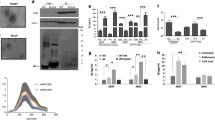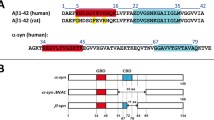Abstract
Increasing evidence indicates that cell surfaces are early interaction sites for Aβ-derived diffusible ligands (ADDLs) and neurons in Alzheimer’s disease (AD) pathogenesis. Our previous data showed significant oxidative damage at the plasma membrane in fibroblasts from familial AD patients with enhanced Aβ production. Here, we report that lipid rafts, ordered membrane microdomains, are chronic mediators of Aβ-induced lipid peroxidation in SH-SY5Y human neuroblastoma cells overexpressing amyloid precursor protein (APPwt) and APPV717G genes and in fibroblasts bearing the APPV717I gene mutation. Confocal microscope analysis showed that Aβ-oxidised rafts recruit more ADDLs than corresponding domains in control cells, triggering a further increase in membrane lipid peroxidation and loss of membrane integrity. Moreover, amyloid pickup at the oxidative-damaged domains was prevented by enhanced cholesterol levels, anti-ganglioside (GM1) antibodies, the B subunit of cholera toxin and lipid raft structure alteration. An enhanced structural rigidity of the detergent-resistant domains, isolated from APPwt and APPV717G cells and exposed to ADDLs, indicates a specific perturbation of raft physicochemical features in cells facing increased amyloid assembly at the membrane surface. These data identify lipid rafts as key mediators of oxidative damage as a result of their ability to recruit aggregates to the cell surface.






Similar content being viewed by others
References
Hardy J, Selkoe DJ (2002) The amyloid hypothesis of Alzheimer’s disease: progress and problems on the road to therapeutics. Science 297:353–356
Walsh DM, Klyubin I, Fadeeva JY, Callen WK, Anvyl R, Wolfe MS, Rowan MJ, Selkoe DJ (2002) Naturally secreted oligomers of amyloid β protein potently inhibit hippocampal long-term potentiation in vivo. Nature 416:535–539
Tomic JL, Pensalfini A, Head E, Glabe CG (2009) Soluble fibrillar oligomer levels are elevated in Alzheimer’s disease brain and correlate with cognitive dysfunction. Neurobiol Dis 35:352–358
Kayed R, Sokolov Y, Edmonds B, McIntire TM, Milton SC, Hall JE, Glabe CG (2004) Permeabilization of lipid bilayers is a common conformation-dependent activity of soluble amyloid oligomers in protein misfolding diseases. J Biol Chem 279:46363–46366
Lal R, Lin H, Quist AP (2007) Amyloid beta ion channel: 3D structure and relevance to amyloid channel paradigm. Biochim Biophys Acta 1768:1966–1975
Yip CM, McLaurin J (2001) Amyloid-β peptide assembly: a critical step in fibrillogenesis and membrane disruption. Biophys J 80:1359–1371
Cecchi C, Fiorillo C, Baglioni S, Pensalfini A, Bagnoli S, Nacmias B, Sorbi S, Nosi D, Relini A, Liguri G (2007) Increased susceptibility to amyloid toxicity in familial Alzheimer’s fibroblasts. Neurobiol Aging 28:863–876
Stefani M, Dobson CM (2003) Protein aggregation and aggregate toxicity: new insights into protein folding, misfolding diseases and biological evolution. J Mol Med 81:678–699
Allen JA, Halverson-Tamboli RA, Rasenick MM (2007) Lipid raft microdomains and neurotransmitter signalling. Nat Neurosci 8:128–140
Kusumi A, Suzuki K (2005) Toward understanding the dynamics of membrane raft-based molecular interactions. Biochim Biophys Acta 1746:234–251
Yoon IS, Chen E, Busse T, Repetto E, Lakshmana MK, Koo EH, Kang DE (2007) Low-density lipoprotein receptor-related protein promotes amyloid precursor protein trafficking to lipid rafts in the endocytic pathway. FASEB J 21:2742–2752
Taylor DR, Hooper NM (2006) The prion protein and lipid rafts. Mol Membr Biol 23:89–99
Kim SI, Yi JS, Ko YG (2006) Amyloid beta oligomerization is induced by brain lipid rafts. J Cell Biochem 99:1878–1889
Saavedra L, Mohamed A, Ma V, Kar S, Posese de Chaves E (2007) Internalization of β-amyloid peptide by primary neurons in the absence of apolipoprotein E. J Biol Chem 282:35722–35732
Williamson R, Usardi A, Hanger DP, Anderton BH (2008) Membrane-bound β-amyloid oligomers are recruited into lipid rafts by a fyn-dependent mechanism. FASEB J 22:1552–1559
Cecchi C, Nichino D, Zampagni M, Bernacchioni C, Evangelisti E, Pensalfini A, Liguri G, Gliozzi A, Stefani M, Relini A (2009) A protective role for lipid raft cholesterol against amyloid-induced membrane damage in human neuroblastoma cells. Biochim Biophys Acta 1788:2204–2216
The Dementia Study Group of the Italian Neurological Society (2000) Guidelines for the diagnosis of dementia and Alzheimer’s disease. Ital J Neurol Sci 21:87–194
Wirths O, Thelen KM, Lütjohann D, Falkai P, Bayer TA (2007) Altered cholesterol metabolism in APP695-transfected neuroblastoma cells. Brain Res 1152:209–214
Pensalfini A, Zampagni M, Liguri G, Becatti M, Evangelisti E, Fiorillo C, Bagnoli S, Cellini E, Nacmias B, Sorbi S et al (2010) Membrane cholesterol enrichment prevents Abeta-induced oxidative stress in Alzheimer’s fibroblasts. Neurobiol Aging (in press)
Bradford MM (1976) A rapid and sensitive method for the quantitation of microgram quantities of protein utilizing the principle of protein-dye binding. Anal Biochem 72:248–254
Tamboli IY, Prager K, Barth E, Heneka M, Sandhoff K, Walter J (2005) Inhibition of glycosphingolipid biosynthesis reduces secretion of the β-amyloid precursor protein and amyloid β-peptide. J Biol Chem 280:28110–28117
Rasband WS (1997–2008) ImageJ. U. S. National Institutes of Health, Bethesda, Maryland. http://rsb.info.nih.gov/ij/
Cecchi C, Rosati F, Pensalfini A, Formigli L, Nosi D, Liguri G, Dichiara F, Morello M, Danza G, Pieraccini G et al (2008) Seladin-1/DHCR24 protects neuroblastoma cells against Aβ toxicity by increasing membrane cholesterol content. J Cell Mol Med 12:1990–2002
Butterfield DA, Reed T, Newman SF, Sultana R (2007) Roles of amyloid beta-peptide-associated oxidative stress and brain protein modifications in the pathogenesis of Alzheimer’s disease and mild cognitive impairment. Free Radic Biol Med 43:658–677
Tampellini D, Magrané J, Takahashi RH, Li F, Lin MT, Almeida CG, Gouras GK (2007) Internalized antibodies to the Abeta domain of APP reduce neuronal Abeta and protect against synaptic alterations. J Biol Chem 282:18895–18906
Demuro A, Mina E, Kayed R, Milton S, Parker I, Glabe CG (2005) Calcium dysregulation and membrane disruption as a ubiquitous neurotoxic mechanism of soluble amyloid oligomers. J Biol Chem 280:17294–17300
Montine KS, Quinn JF, Zhang J, Fessel JP, Robert LJ II, Morrow JD, Montine TJ (2004) Isoprostanes and related products of lipid peroxidation in neurodegenerative diseases. Chem Phys Lipids 128:117–124
Abdul HM, Sultana R, St Clair DK, Markesbery WR, Butterfield DA (2008) Oxidative damage in brain from human mutant APP/PS-1 double knock-in mice as a function of age. Free Radic Biol Med 45:1420–1425
Murray IV, Liu L, Komatsu H, Uryu K, Xiao G, Lawson JA, Axelsen PH (2007) Membrane-mediated amyloidogenesis and the promotion of oxidative lipid damage by amyloid beta proteins. J Biol Chem 282:9335–9345
Shaked GM, Kummer MP, Lu DC, Galvan V, Bredesen DE, Koo EH (2006) Abeta induces cell death by direct interaction with its cognate extracellular domain on APP (APP 597–624). FASEB J 20:1254–1256
Simons K, Toomre D (2000) Lipid rafts and signal transduction. Nat Rev Mol Cell Biol 1:31–39
Arispe N, Doh M (2002) Plasma membrane cholesterol controls the cytotoxicity of Alzheimer’s disease Abeta (1–40) and (1–42) peptides. FASEB J 16:1526–1536
Kwik J, Boyle S, Fooksman D, Margolis L, Sheetz MP, Edidin M (2003) Membrane cholesterol, lateral mobility, and the phosphatidylinositol 4, 5-bisphosphate-dependent organization of cell actin. Proc Natl Acad Sci USA 100:13964–13969
Fujita A, Cheng J, Hirakawa M, Furukawa K, Kusunoki S, Fujimoto T (2007) Gangliosides GM1 and GM3 in the living cell membrane form clusters susceptible to cholesterol depletion and chilling. Mol Biol Cell 18:2112–2122
Lichtenberg D, Goñi FM, Heerklotz H (2005) Detergent-resistant membranes should not be identified with membrane rafts. Trends Biochem Sci 30:430–436
Goins B, Masserini M, Barisas BG, Freire E (1986) Lateral diffusion of ganglioside GMl in phospholipid bilayer membranes. Biophys J 9:849–856
Acknowledgements
The authors would like to thank Daniel Wright for the critical reading of the manuscript. This study has been supported by grants from the Italian MIUR (PRIN project no. 2008R25HBW_002), from the Fondazione Cassa di Risparmio di Pistoia e Pescia (project no. 2009.0202) and Fondazione San Paolo (Alzheimer).
Funding
All authors declare the absence of any actual or potential conflicts of interest including any financial, personal or other relationships with other people or organisations within 2 years of beginning the work submitted that could inappropriately influence (bias) their work. All data contained in the manuscript being submitted have not been previously published, have not been submitted elsewhere and will not be submitted elsewhere while under consideration at Journal of Molecular Medicine. All authors have reviewed the contents of the manuscript being submitted, approve of its contents and validate the accuracy of the data.
Author information
Authors and Affiliations
Corresponding author
Rights and permissions
About this article
Cite this article
Zampagni, M., Evangelisti, E., Cascella, R. et al. Lipid rafts are primary mediators of amyloid oxidative attack on plasma membrane. J Mol Med 88, 597–608 (2010). https://doi.org/10.1007/s00109-010-0603-8
Received:
Revised:
Accepted:
Published:
Issue Date:
DOI: https://doi.org/10.1007/s00109-010-0603-8




